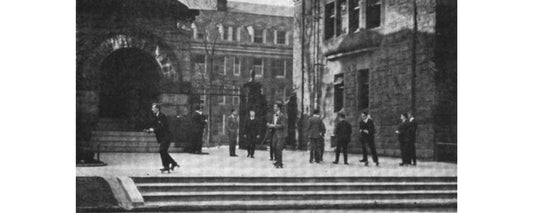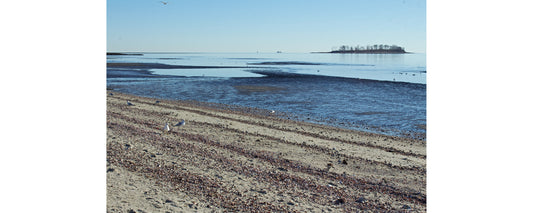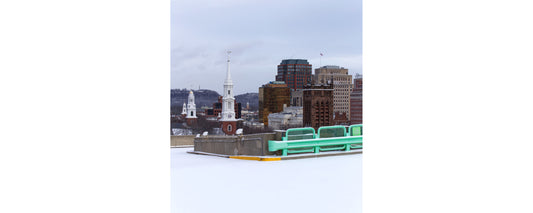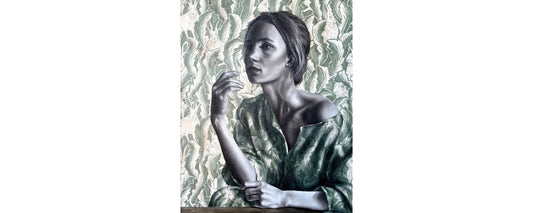Once she discovered the “sharp edges” of a history “sanded down,” author Anne Gardiner Perkins couldn’t turn back. A 1981 graduate of Yale who was the first female editor-in-chief of the Yale Daily News, Perkins knew something about the history of the university’s move to coeducation in 1969. But as she pursued a doctorate in higher education later in life, she learned more about what happened next.
The transition story she’d heard, Perkins writes, “was a sanitized tale of equity instantly achieved, as if all it took to transform these villages of men into places where women were treated as equals was the flip of an admissions switch.” In her book Yale Needs Women: How the First Group of Girls Rewrote the Rules of an Ivy League Giant (2019), which won the 2020 Connecticut Book Award for nonfiction, Perkins sets out to resharpen that 50-year-old history. The New Haven Museum is sponsoring a Zoom presentation based on the book on March 4 at 6 p.m., including a conversation among Perkins; New Haven leader Constance Royster, who is featured in the book; current Yale Daily News editor in chief Mackenzie Hawkins; and Zoe Hopson, president of the Yale Black Women’s Coalition, which also figures in the story.
sponsored by
While many know—or remember firsthand—the turbulence of New Haven in the late 1960s and early 1970s, it’s striking to be reminded of how many seminal events occurred in a single school year. Between September of 1969, when the first 575 female undergraduates set foot on campus—230 freshmen, 151 sophomores and 194 juniors—and September of 1970, New Haven saw a major antiwar demonstration on the Green, part of the national Moratorium to End the War in Vietnam; the trial of Black Panther Party members and the resulting May Day protest rally; and an August protest called the Women’s Strike for Equality, held as the House of Representatives began to debate the Equal Rights Amendment.
The bulk of Yale Needs Women covers this fateful year. Following the stories of five of Yale’s first female undergrads and a cast of other players, Perkins takes readers through the unanticipated struggles of the “coeds,” from the simply annoying—being ogled every time they walked across the dining hall for a fresh cup of coffee—to the downright dangerous—being attacked at knifepoint in the shower because the head of housekeeping refused to install locks on the bathroom doors.
What emerges is a portrait of a university woefully and sometimes willfully unprepared to support the women it had admitted. Yale had been enrolling women in graduate programs in small numbers since 1869, beginning with the School of Fine Arts. But admitting younger women in larger numbers was altogether different. Outnumbered by men five to one, Yale’s undergraduate women were divided among all 12 of Yale’s residential colleges, making them feel isolated. The situation was even more challenging for the freshman class’s 25 Black women. Some were used to being surrounded by white peers, but others found themselves in a school full of white people for the first time.
The women were banned from many university clubs, and little thought was given to their physical safety. Particularly galling to them was university president Kingman Brewster’s oft-repeated tagline, “a thousand male leaders.” Admission quotas, Perkins reports, held 1,025 places per class for men (with “a cushion of 25 extra in case the admissions office made some mistakes”) and 230 for women. “The phrase rankled, and some women liked to extend it: ‘one thousand male leaders and two hundred concubines,’ they would say to each other, underscoring what the tagline implied for their own status… The women were add-ons.”
Take, for example, student Lawrie Mifflin, who arrived at Yale with her field hockey stick only to find out there was no women’s team—in any sport. Her choices for athletics were classes in modern dance, ballet, “women’s exercise” and synchronized swimming; exercising the polo ponies for the men’s team; or cheerleading on a co-ed team that was willing to accept four women. Mifflin eschewed those options and organized a pickup group that shot field hockey balls back and forth on the Old Campus lawn. By her senior year, field hockey had attained varsity status. Still, when Mifflin demanded coverage of her team and the other women’s sports from the Yale Daily News, male reporters took little interest. So she covered women’s sports herself. She went on to a journalism career at The New York Times.
At the root of many of the problems in those early years, as Perkins tells it, was the imbalance in numbers between women and men. This issue provides the arc of the action in Yale Needs Women as, over the course of nearly four years, the pressure mounts from all sides—including the Yale men themselves—for Brewster to give in and admit a larger percentage of women. Among those calling for the president to give up gender-based quotas were Admissions Committee members, who registered their “dismay” that if they had been allowed to choose the class of 1974 “without regard to gender…, three hundred acceptance letters that were just mailed to men would have been sent instead to women.” The problem, Perkins writes, wasn’t just at Yale: “A 1970 American Council on Education study found that male high school students in the top fifth of their class had a 92 percent chance of being accepted by a selective U.S. college, while the odds dropped to 62 percent for the top-ranked high school girls.”
No principal hero emerges from this saga full of subplots. But the heroic efforts of Elga Wasserman beat like a drum throughout Yale Needs Women. With her PhD in chemistry from Harvard, Wasserman had come to Yale with her identically credentialed husband, Harry, in 1948. He was offered a tenure track position. She became a lab assistant. She also taught courses at Southern Connecticut State University and raised the couple’s three children. By the fall of 1968, Wasserman had risen, by hard work and luck, to the rank of assistant dean at the Yale Graduate School. Brewster asked her to spearhead the shift to coeducation, and she accepted, despite her distaste for the title she was offered: Special Assistant to the President on the Education of Women.
The long-suffering Wasserman spent the next few years writing memos, making demands, surrounding herself with more powerful allies, responding to the female students’ concerns and raising her own funding (never mind that it irked the development office). “She was our go-to person,” Royster told Perkins, “and she did anything and everything that she could for us.” As a reward for her hard work, Wasserman’s position was eventually eliminated, and she was turned down for all other job openings. She then did what any sensible Yale woman would do: She went back to school. At the age of 58, she entered Yale School of Law and later practiced family law in New Haven.
Yale Needs Women is full of stories like these, recapturing a time and a place in some ways nearly unrecognizable today, with women making up 54.9% of all college students in the US, according to 2018 census data, and Title IX, adopted in 1972, significantly leveling playing fields both literal and figurative. But in other ways, as Perkins points out, women in higher education continue to face an uphill battle. Only 32 percent of full professors and 26 percent of college and university presidents are women. And one in five women students reports being sexually assaulted during her college years.
It’s another sharp-edged story that deserves to be told.
Yale Needs Women: How the First Group of Girls Rewrote the Rules of an Ivy League Giant
by Anne Gardiner Perkins
RJ Julia | Barnes & Noble | IndieBound
Books can also be purchased by contacting the New Haven Museum.
Author event: March 4 at 6pm; register here
Written by Kathy Leonard Czepiel. Photographed by Dan Mims.








